26 Bills Later: Legislation During the ‘Zombie Parliament’
Was the 2013-15 session a ‘zombie parliament’? Gavin Freeguard looks at the law data.
We now have a full list of primary legislation passed into law in the 2014-15 parliamentary session under the Coalition – and during the whole 2010-15 parliament. Did it become, as some suggested, a ‘zombie parliament’? Gavin Freeguard looks at the law data. We have excluded private bills, private members’ bills, secondary legislation like statutory instruments and bills which did not receive Royal Assent from our analysis. Click images to enlarge
26 government bills were passed during the 2014-15 parliamentary session...
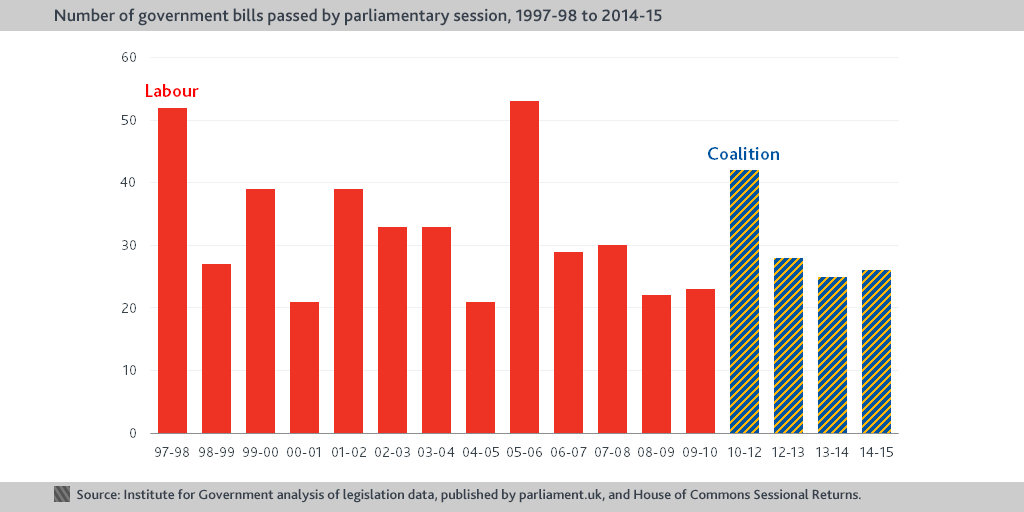
The 2014-15 parliamentary session was the second quietest under the Coalition in terms of the total number of government bills that received Royal Assent and became law. 26 government bills received Royal Assent during the 2014-15 session, one more than in 2013-14 (25) and two fewer than in 2012-13 (28). As with every parliament since 1997, it was the first session of the parliament in which the greatest number of bills were passed (42 in 2010-12).
…which is roughly one government bill becoming law every five sitting days.
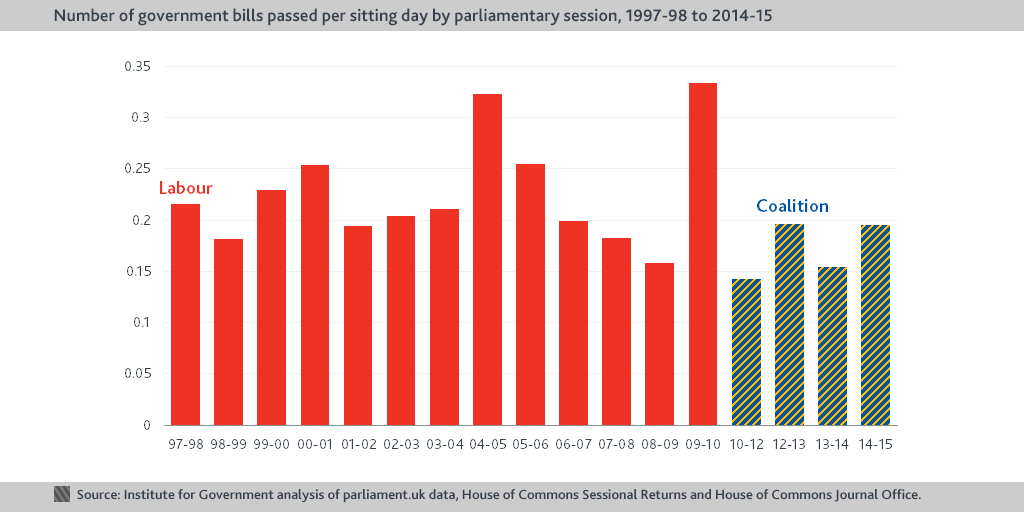
However, parliamentary sessions vary in length, and we get a different picture if we look at the number of government bills passed into law by parliamentary sitting day. In the final session of the last parliament, one government bill was passed into law roughly every five sitting days, making it the second busiest session under the Coalition (0.195 bills per sitting day, compared to 0.196 in 2012-13). This contrasts with all three New Labour parliaments (1997-2001, 2001-05 and 2005-10), where the final session in each parliament was the busiest. In both 2004-05 and 2009-10, one government bill was passed every three sitting days in the rush to get legislation through before the end of the Parliament. It may be that the Fixed-term Parliaments Act (giving greater certainty to the parliamentary timetable), or simply a coalition government having less political room for manoeuvre, has helped avoid such a rush this time round.
This relative legislative calm has given rise to the term ‘zombie parliament’, which has stumbled lifelessly into recent political analysis. The reality is more complicated: rather than descending into a chamber of the voting dead as the 2010-15 parliament progressed, it was actually the first session where fewest bills were passed by sitting day. The 2012-13 and 2014-15 sessions are comparable to some parliamentary sessions during the New Labour years. In any case, as our own Jill Rutter has previously written, there may be more productive uses for Parliament than simply passing new primary legislation, and ConservativeHome’s Peter Hoskin suggests there has been more secondary legislation passed during the last few calendar years.
One government bill has passed every six sitting days under the Coalition, compared to one every four and a half days under New Labour.
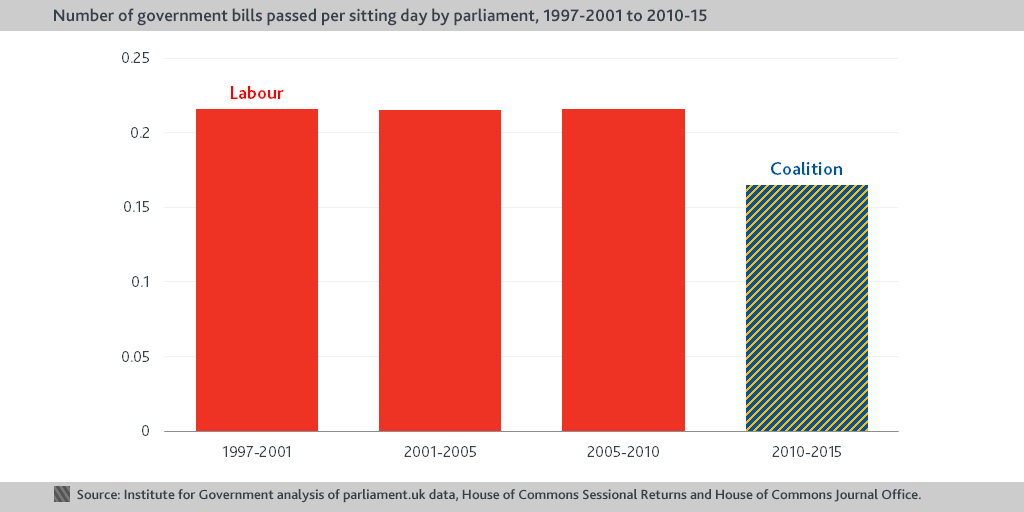
Having said all of that, in terms of primary legislation, Parliament has been quieter under the Coalition than under New Labour. One government bill has made it to Royal Assent every six days since 2010 (a total of 121 bills over 733 sitting days). In each New Labour session, one government bill made it into law every four and a half days (139 in 643 sitting days in 1997-2001, 126 in 585 in 2001-05, and 157 in 727 in 2005-10).
More pages of legislation were passed per sitting day in the 2014-15 session than any other session this parliament.
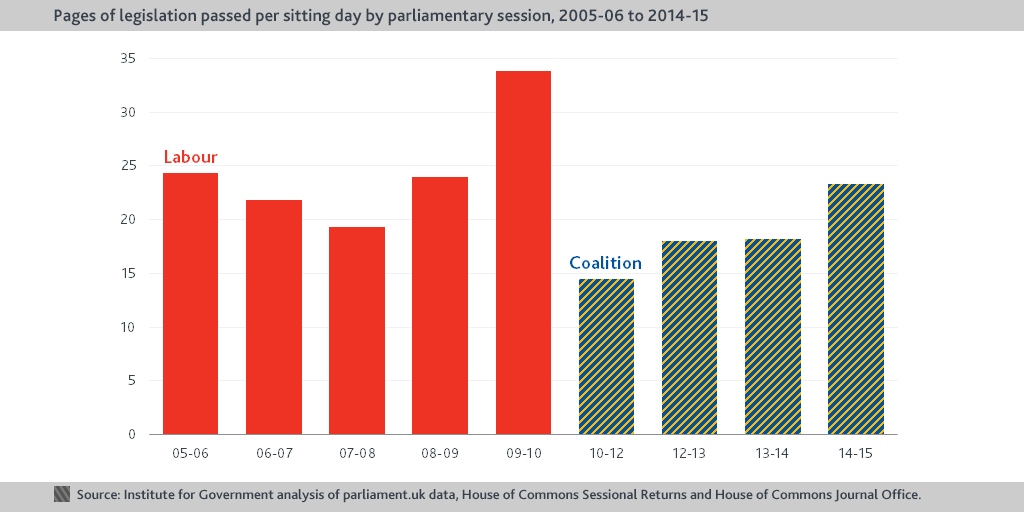
Not all bills are created equal: some are only a few pages long, while others run to many hundreds of pages with hundreds of clauses and multiple schedules (causing many hours of debate). More pages of government legislation were passed per sitting day in 2014-15 – 23.3 pages – than any other session this parliament. It was also comparable with most sessions during the last New Labour parliament with the exception of 2009-10, when 33.3 pages were passed per sitting day.
Most government bills receiving Royal Assent are under 100 pages long but there are some outliers, with the Treasury having the longest bills.
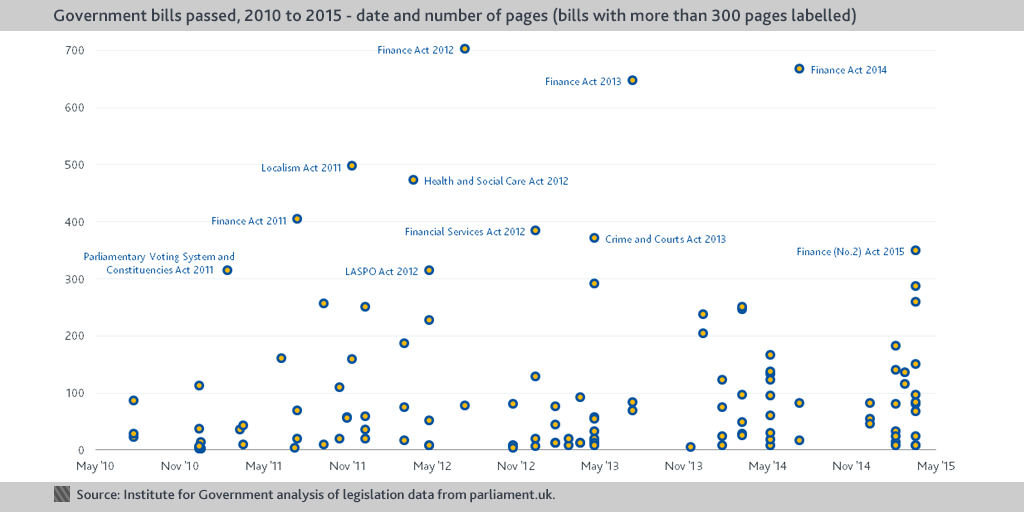
Charting the length of bills against the date on which they received Royal Assent, two things are obvious. The first is that, given that bills introduced at the start of a session tend to receive Royal Assent by the end of the same session, there is a cluster of bills passed towards the end of most parliamentary sessions – April 2013, May 2014, and March 2015, though noticeably not May 2012. The second is that most government bills becoming law were under 300 pages long – 47% were under 50 pages and 69% under 100 pages long. Those over 300 pages include the Finance Acts of 2011, 2012, 2013, 2014 and 2015, which renew taxes and put new taxes announced in the Budget into law. The others were:
- Parliamentary Voting System and Constituencies Act 2011 (314 pages), which legislated to allow the Alternative Vote (subject to referendum), reducing the number of MPs to 600 and reviewing constituency boundaries (though political brokering means some of this has not been implemented)
- Legal Aid, Sentencing and Punishment of Offenders Act 2012 (314 pages), which instituted a number of justice reforms
- Crime and Courts Act 2013 (371 pages), which covered numerous matters from the National Crime Agency to the Leveson Report
- Financial Services Act 2012 (385 pages), which made various provisions about financial services and markets
- Health and Social Care Act 2012 (473 pages), which introduced reforms to the health system (such as increasing the power of GPs to commission services)
- Localism Act 2011 (497 pages), which devolved powers (including over housing and planning) to councils and communities.
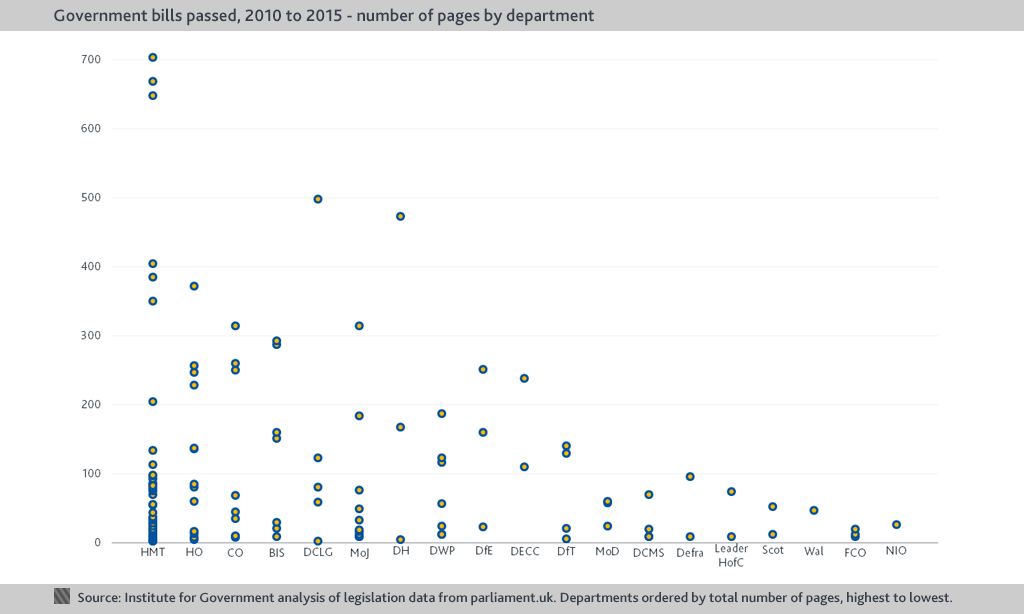
Given the length of the Finance Acts, it is perhaps unsurprising that the Treasury has passed the most pages of legislation during the course of the 2010-2015 parliament.
The Treasury has been responsible for the most government bills receiving Royal Assent this parliament.
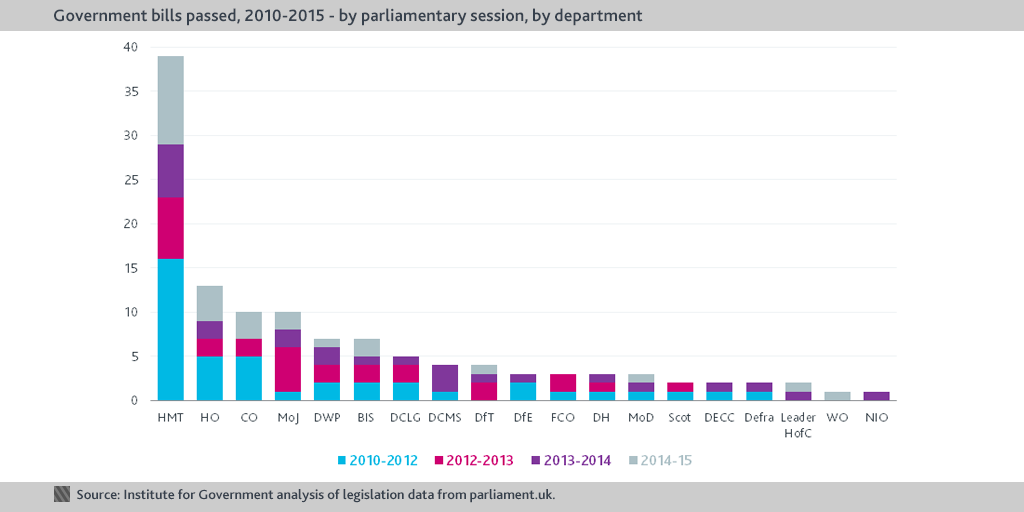
The Treasury has also had more bills – 39 – receive Royal Assent this Parliament than any other department. Although these have included reforms to the financial system, National Insurance and taxes, many of them have been bills which allow the government to raise and spend money, such as Finance Bills and Supply and Appropriation Bills. This is unlikely to change during the next Parliament, and the Treasury will need to ensure it remains equipped to steer a large volume of legislation through Parliament. But – as Gus O’Donnell and others have noted – with minority or Coalition government a possibility after the General Election, the greater difficulty of achieving political consensus on legislation may mean that the volume of legislation reduces further still. Our charts could look rather different after the next parliamentary session, whoever ends up in government.
- Administration
- Cameron-Clegg coalition government
- Publisher
- Institute for Government